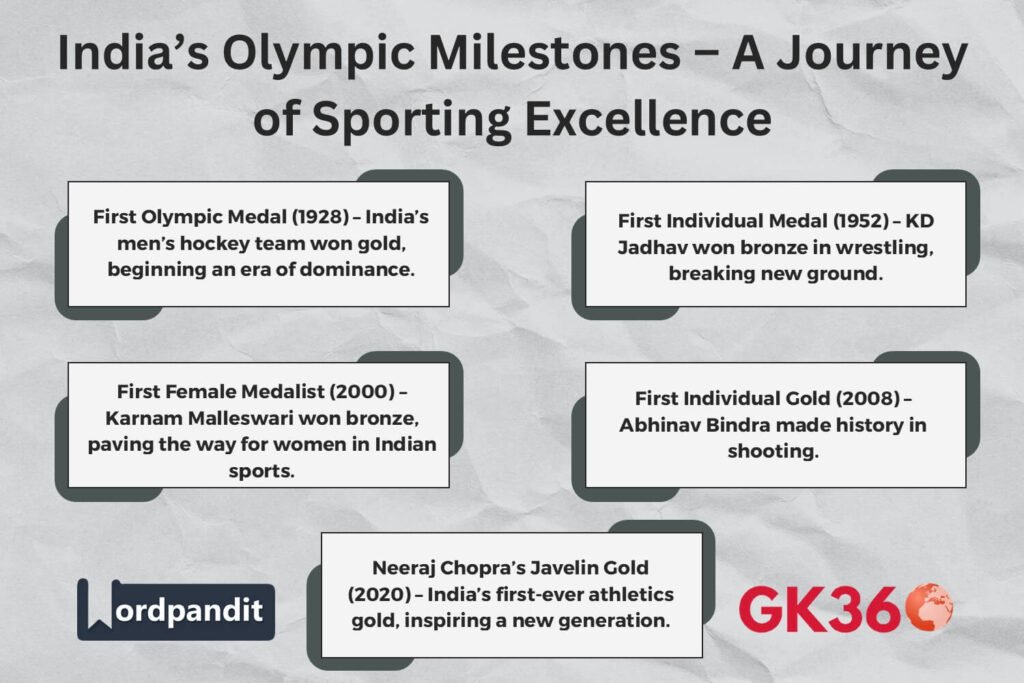India’s Olympic Journey: History, Achievements, and Future Aspirations
Introduction
Imagine a stadium filled with thousands of spectators, their collective breath held as an Indian athlete stands poised to make history. The anticipation is electric. This moment captures the dreams and aspirations of a billion people who see the Olympics as more than a sporting event—it is a testament to India’s prowess, resilience, and sporting spirit.
In a country where cricket reigns supreme, the Olympics provide a distinct platform where individual talent and national pride converge. But how has India performed in this prestigious global arena? This article explores India’s journey in the Olympics, highlighting its achievements, challenges, and the path forward.

Table of Contents
- India’s Olympic Beginnings
- Post-Independence Challenges
- The Rise of New Olympic Heroes
- India’s Performance in the 21st Century
- Government Initiatives and Policies
- Future Aspirations: India’s Road to Olympic Excellence
- FAQs
1. India’s Olympic Beginnings
India’s Olympic story began in 1900 when Norman Pritchard, a British-Indian athlete, won two silver medals in athletics. However, it was not until 1920 that India sent its first official team to the Olympics. The breakthrough came in 1928 when the Indian men’s field hockey team won its first gold medal, marking the start of an era of dominance with six consecutive gold medals until 1956.
2. Post-Independence Challenges
After independence, India struggled to maintain its Olympic momentum. The decline of the hockey team in the 1960s and 70s reflected broader issues: inadequate infrastructure, lack of structured training programs, and minimal financial support. Unlike countries like China and the Soviet Union, India lacked a cohesive strategy to develop and nurture sports talent.
3. The Rise of New Olympic Heroes
The 1980s and 90s witnessed individual athletes breaking barriers:
- PT Usha: Narrowly missed a medal in the 1984 Olympics, inspiring future athletes.
- Leander Paes: Won a bronze medal in tennis at the 1996 Olympics, India’s first in an individual event in over four decades.
- Karnam Malleswari: Became India’s first female Olympic medalist with a bronze in weightlifting at the 2000 Olympics.
4. India’s Performance in the 21st Century
India saw a significant shift in its Olympic fortunes in the 2000s:
- Abhinav Bindra (2008): First Indian to win an individual Olympic gold (shooting).
- Mary Kom, Saina Nehwal, PV Sindhu: Trailblazers in boxing and badminton, securing medals for India.
- Neeraj Chopra (2020): First-ever Indian to win gold in athletics (javelin throw).
5. Government Initiatives and Policies
To improve India’s Olympic performance, the government launched initiatives like:
- Target Olympic Podium Scheme (TOPS): Financial and training support for elite athletes.
- Khelo India: Grassroots sports development program to identify and nurture young talent.
- Sports Authority of India (SAI): Provides state-of-the-art training facilities and international exposure to athletes.
6. Future Aspirations: India’s Road to Olympic Excellence
India aims to rank among the top 10 nations in the Olympic medal tally by 2030. To achieve this:
- Investment in Sports Infrastructure: Building world-class training facilities across the country.
- Public-Private Partnerships: Encouraging corporate sponsorship and funding for athletes.
- Emphasis on Mental and Physical Well-being: Ensuring athletes receive holistic training and psychological support.
- Encouraging Women in Sports: Strengthening support systems for female athletes.
7. FAQs
- What was India’s best Olympic performance?
India’s best Olympic performance was at the Tokyo 2020 Olympics, where it won seven medals, including Neeraj Chopra’s historic gold in javelin. - Who is India’s most successful Olympian?
Shooter Abhinav Bindra remains India’s most successful Olympian, being the only individual gold medalist before Neeraj Chopra. - How does India compare to other nations in the Olympics?
While India has shown remarkable improvement, it still lags behind top-performing nations like the US, China, and Japan. However, with structured programs, India aims to break into the top 10 in the coming decades. - What is the role of private organizations in supporting Indian athletes?
Organizations like Olympic Gold Quest (OGQ) and JSW Sports play a crucial role in funding, training, and mentoring athletes. - Can India host the Olympics in the future?
India has expressed interest in hosting the 2036 Olympics, but significant infrastructure development and strategic planning will be required.
Conclusion
India’s Olympic journey reflects a story of resilience and perseverance. While challenges remain, the country has taken significant strides toward sporting excellence. With continued investment in infrastructure, training, and athlete welfare, India is poised for greater success on the Olympic stage.
As sports enthusiasts, educators, and policymakers, it is crucial to support and celebrate India’s athletes, ensuring that future generations have the resources and encouragement to bring home Olympic glory.
Key Takeaways Table
| Aspect | Details |
|---|---|
| India’s First Olympic Medal | 1928 Hockey Gold |
| First Individual Medalist | KD Jadhav (Wrestling, 1952) |
| First Female Olympic Medalist | Karnam Malleswari (Weightlifting, 2000) |
| Most Successful Olympian | Abhinav Bindra – India’s First Individual Gold Medalist (2008) |
| Best Olympic Performance | Tokyo 2020 – 7 Medals, Including Neeraj Chopra’s Gold |
| Key Government Programs | Khelo India, TOPS, Sports Authority of India (SAI) |
| Future Goals | Top 10 in Olympic Medal Rankings by 2030 |
Related Terms:
- India’s Olympic History and Achievements
- India’s First Olympic Medal
- Neeraj Chopra Gold Medal 2020
- Khelo India and TOPS Program
- India’s Future Olympic Aspirations
- Best Indian Olympic Athletes
- Women in Indian Sports
- India’s Olympic Medal Tally 2024
- Indian Athletes in Paris 2024
- Olympic Sports Development in India






